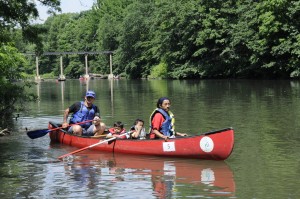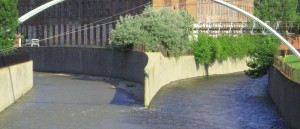A brief history of a complex movement and what two programs can show us about its future.

Community members paddling at the 2008 Bronx River Festival. 2000 people, including 800 students, participated in canoe tours in 2013. Photo courtesy of Bronx River Alliance.
Before Damian Griffin became Chief Educator at the Bronx River Alliance, he taught elementary and middle school students in the Bronx as a bilingual teacher.
“In all of my classes,” Griffin said, “I’ve always wanted to connect my students to the community outside the building.”
Last year, the Bronx River Alliance Education Program worked with 200 teachers and 2500 students. The program trains teachers in water quality monitoring and provides lesson plans and resources to get students involved in stewardship of the river.
Griffin’s program focuses on local schools around the Bronx River Watershed, one of the poorest urban congressional districts in the US, with almost 50% of children living in poverty.
800 students a year participate in canoe tours of the river. Urban environmental education, Griffin says, is “not so much about the lesson plan. It’s about the overall experience.”
What do students gain from the experience? Why are teachers and environmental educators invested in environmental education programs? How has urban environmental education grown and changed, and what are its goals?
The history of urban environmental education in the United States is far reaching and its goals are diverse, but we can trace a path through the ongoing dialogue to understand how urban environmental education developed its current complexity.
Urban educators have used the city as a classroom for over half a century. In the 1950s, students in the Bronx studied nature science on local trails, and the NYC Board of Education developed a curriculum to teach students nature science using local nature.
Around 1970, the term “urban environmental education” came into use, and already scholars and educators were discussing what would make environmental education relevant to city students. In 1972, D. J. Clark wrote that minority urban citizens, who are particularly exposed to environmental hazards like pollution and spills, can feel alienated from many environmental issues as they focus on pressing issues like violence and poverty.
As urban environmental education became more widespread, the conversation about relevancy continued into the 1990s. An EPA research report, which looked at environmental action in cities, explored the disparities between the mainstream environmental movement and the “significant grassroots work being done to educate urban minorities of environmental risks in their community.” Environmental justice communities like the South Bronx face disproportionate environmental hazards and pollution from large highways, waste treatment plants, and energy facilities that wealthier communities force out. Researchers and educators started to incorporate this reality into the environmental education conversation.
A 2013 Cornell University dissertation found that many educators have begun seeing cities as “social-ecological systems in which both social and natural components are essential.”
Programs have goals that span from community development to problem solving to city as classroom, and the organizations that run environmental programs range from governmental nonprofits to local churches, from grassroots groups to public schools.
But across the diversity of programs, this understanding of the urban environment–as a unified social-ecological ecosystem–guides many programs that are both place-based and action-based. To get students invested in canoe trips and water quality testing on the Bronx River, Griffin said, you have to help them feel connected to their river.
In the Bronx, this sometimes means talking about the environmental justice problem that limit access to the Bronx River. Griffin said it is motivating to “let young people in the neighborhood know that…there’s something, human decision, human impact that’s not allowing them” to access the nature in their communities.
In North Adams, Massachusetts, a small city 150 miles from the South Bronx, students at the E3 Academy got connected to their own river last fall.
E3 is a small program of the local high school for over-aged, under-credited students who are at risk of dropping out. The students are all low income, and many come to E3 with very low attendance rates.
Graduation at E3 is competency based, meaning students must master competencies like solving multivariable equations or writing a persuasive essay (instead of earning a certain number of credits) to graduate.
Each trimester, E3 focuses on a theme, and students do a service-learning project on that theme. For their fall trimester project, the nine students built a trail along the local Hoosic River.

The Hoosic River was rerouted into flood chutes in the 1950s. Photo courtesy of the North Adams Chamber of Commerce.
Because of flooding, the Hoosic was rerouted into concrete flood chutes in the 1950s. “As a result many people in North Adams are very disconnected from the river,” said Abby Reifsnyder, the clinical social worker at E3. “It actually looks more like a sewer than a normal river.”
The three staff members at E3 used the Hoosic River as a theme to tie into subjects students were already required to learn. Students could study not only the environmental science of the river but also the history of the river, which powered the textile mills that were the first industry of the city of North Adams.
In September 2013, E3 adopted a portion of the river to turn into a trail. An old footpath there was completely overgrown with invasive Japanese knotweed, and residents had dumped enormous quantities of trash into the area from a road uphill. Students worked on the trail until the beginning of December.
Students removed garbage that included beer bottles, baby diapers, a microwave, and eight shopping carts from their trail. They pulled up so much knotweed, Reifsnyder says, that “we got the town department of public works to bring a dump truck and a backhoe.” The knotweed students removed from the path filled multiple dump truck loads.
Reifsnyder said the project helped students take ownership not just of their trail but also of their city. “Many young people in North Adams tend to speak negatively about the city. By the end of this project these students were talking about North Adams with pride.”

Two E3 students built a sign for the new Willow Walk trail, which opened in December. Photo courtesy of the Hoosic River Revival.
E3 celebrated the opening of the trail in December with community members, including the mayor. Students presented a Powerpoint of the project, served trail mix, and took everyone on a walk along the new trail, which they named Willow Walk.
“When they saw at the end that what they made was special enough that the newspapers came, that the mayor came and congratulated them,” said Reifsnyder, “they felt much more empowered about what they can do in their own lives.”
Adding their experience to the conversation that started over 50 years ago, programs like E3 and the Bronx River Alliance are exploring the future of urban environmental education.
Where is that future headed?
Urban environmental programs become relevant when they are rooted in place and related to students’ lives. “We picked the Hoosic River because that’s our river,” Reifsnyder said.
Urban environmental programs become sustainable when they incorporate skills students already need to learn. The Bronx River Alliance offers teachers training and resources to incorporate the river into their curricula. The staff at E3 used the Hoosic River and their project to motivate students and teach competencies that helped all nine students pass their standardized tests.
Right now, many urban environmental education programs are small and local. How can this kind of success expand without sacrificing its place-based, community-based nature? How can the momentum of the growing urban environmental movement bring relevant, sustainable environmental learning to more under-served students in more cities?
As this series continues, we will compare local and national programs, examine the implications of environmental justice and privilege, and talk to urban students and educators as we search for the answers.